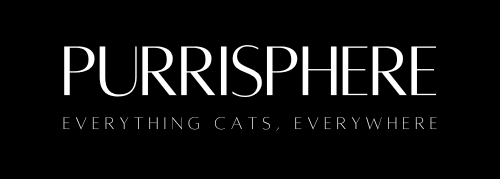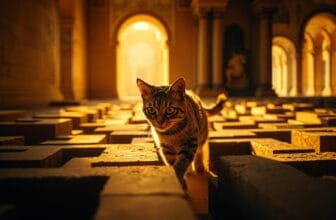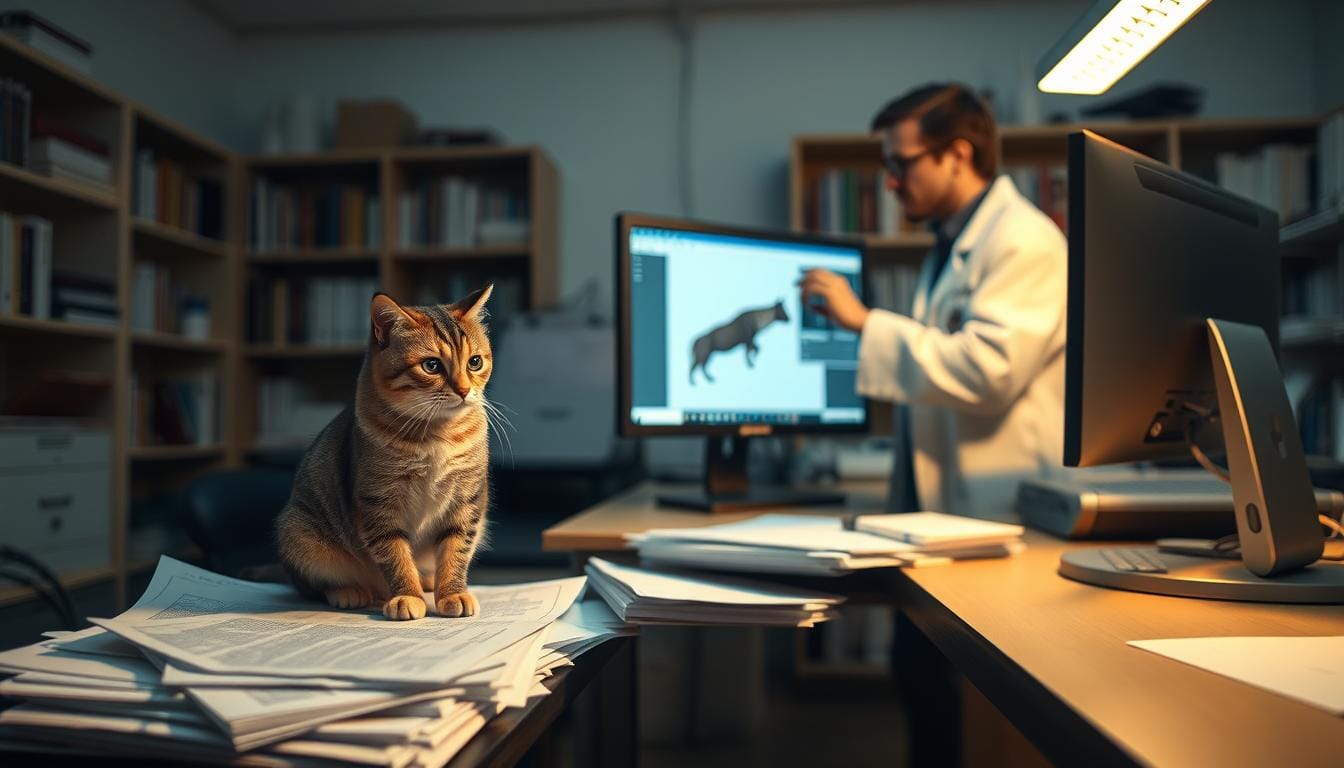
Table of Contents
Ever wonder how your cat remembers where treats are or recognizes you after weeks apart? Cat memory is more than just instinct. It’s a complex world of cognitive processes.
Cats have amazing memory skills. They can learn new behaviors and form strong bonds. Their brains are like advanced memory storage systems, using neural networks to keep information.
Exploring cat memory shows us their learning and survival skills. They can recognize spaces and remember emotions. This surprises both researchers and cat owners.
In this journey into feline memory, you’ll learn about their memory, learning, and interactions. You’ll discover their hidden abilities and appreciate their mental strength.
The Science Behind Feline Memory
Cats have a brain as complex as many mammals. Their brain structure shows they can process and store information with great precision. This makes their memory fascinating to study.
Studies on cat memory are revealing. Their brain is very similar to ours, with about 90% of the same structures. This similarity explains their advanced thinking abilities.
Understanding Brain Complexity
Cats have a brain that supports their memory well. They have:
- 300 million neurons, more than dogs’ 160 million
- Well-developed sensory processing areas
- Good ways to store information
Neurons and Cognitive Function
Neuronal connections are key for cats’ memory. These tiny paths help them:
- Learn complex behaviors
- Recognize familiar places
- Solve problems in a smart way
“A cat’s brain is a marvel of evolutionary design, capable of intricate memory processing that continues to surprise researchers.” – Dr. Feline Neuroscience Research Institute
The Hippocampus: Memory’s Command Center
The hippocampus is key for cat memory. It helps them:
- Create spatial memories
- Remember past experiences
- Find their way in complex places
| Brain Feature | Cat Characteristics | Significance |
|---|---|---|
| Neuron Count | 300 million | High cognitive potential |
| Brain Similarity to Humans | 90% | Advanced memory capabilities |
| Hippocampus Function | Memory processing | Spatial and experiential recall |
By looking into these brain basics, we learn more about cats’ memory. It shows how they interact with their world in amazing ways.
Short-Term vs. Long-Term Memory in Cats
Cats have amazing memory skills that help them get around and interact with their world. They have short-term and long-term memory, each playing a key role in how they remember things.
Short-term memory lets cats hold onto information for a short while. Studies show cats can recall where they last found food for up to 15 minutes. This shows their strong working memory. It helps them:
- Track prey movements
- Remember where they last ate
- Recall recent interactions with humans or other animals
Long-term memory works differently. Cats can keep memories for years. Emotional experiences and big events leave a lasting mark on their minds. They remember:
- Familiar people and friends
- Safe and dangerous places
- Skills they’ve learned and how to survive
“A cat’s memory is not just about remembering, but about survival and adaptation.” – Feline Behavior Experts
Your cat’s memory is more complex than you might think. Their ability to store and recall information is key to their survival and success in their environment.
How Cat Memory Shapes Behavior
Cat memory is key in how cats act and react to their world. It shows how their minds work in complex ways.
Your cat’s memory is more than just remembering faces. It’s a deep system of learning and feeling that guides their day-to-day life.
Learning Through Experience
Cats learn and grow through their memory. They remember past events that shape their future actions. For example, a good memory of someone might make them seek that person out for fun.
- Seeking out that individual for attention
- Displaying welcoming body language
- Remembering safe and comfortable spaces
Memory-Based Reactions
Every cat has personalized memory triggers that affect their actions. These can come from good times, bad times, or regular activities.
- Previous positive encounters
- Traumatic experiences
- Routine interactions
“A cat’s memory is a powerful tool for survival and social interaction.” – Feline Behavior Research Institute
Emotional Associations
Cat memory ties strong emotions to their actions. A single event can leave a lasting mark on how they handle similar situations later.
Knowing how cat memory works helps owners create better homes for their cats.
The Power of Cat Memory in Spatial Navigation
Cats have an amazing ability to remember and navigate their surroundings. Their memory is key to survival and daily life. They create mental maps to guide their movements and understand their environment.
Research shows cats develop this skill through several ways:
- Remembering food and water locations
- Tracking hunting territories
- Identifying safe resting spots
- Avoiding potential dangers
Domestic cats use their spatial memory in interesting ways. They remember where their litter box, favorite sleeping spots, and furniture are. This skill comes from their wild ancestors’ need to navigate complex environments.
“A cat’s spatial memory is like a complex GPS system, helping them understand and interact with their world with incredible accuracy.” – Feline Behavior Experts
Studies show cats can recall food locations even after a long time. Their memory helps them remember which food cups they’ve visited. This shows they have advanced cognitive mapping skills, beyond simple instinct.
Knowing about your cat’s spatial memory can make their environment better. By recognizing their natural skills, you can design spaces that support their cognitive abilities. This provides mental stimulation for them.
Object Permanence in Felines
Cat memory shows us how cats see the world. They understand that objects still exist even when they can’t see them. This is called object permanence.
Object permanence is key to understanding cat memory. Cats learn this skill in stages. They start by recognizing objects and then remember where they are.
Developmental Stages of Object Recognition
Cats go through different stages as they learn about objects:
- They first explore objects with their senses.
- Then, they track moving objects.
- Next, they learn that objects still exist when hidden.
- Finally, they develop better spatial memory.
Hidden Object Recognition Skills
Studies show cats are great at remembering hidden objects. They can:
- Remember where hidden toys are.
- Track prey even when it’s behind something.
- Recall where they hid things in their space.
Feline cognitive research shows cats learn object permanence sooner than human babies. This shows their advanced mental skills. Their instincts help them keep track of their surroundings. They remember where objects are, even if they can’t see them.
Cats don’t just see the world—they remember and anticipate it.
Social Memory and Recognition
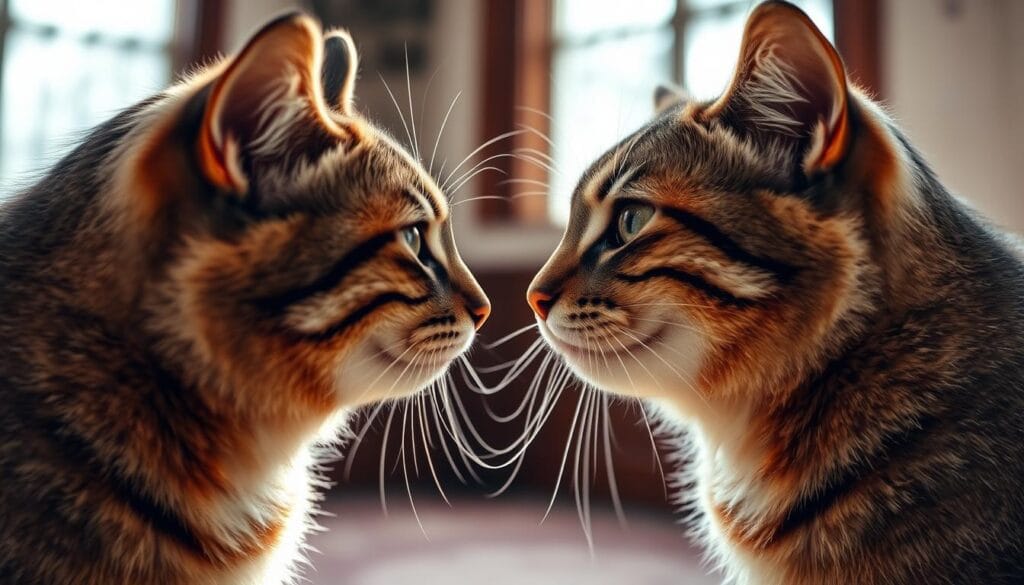
Cats have amazing memory skills that go beyond just recognizing faces. They remember and connect with people, animals, and places in special ways. This shows how smart they are in building relationships.
There are several ways cats remember social connections:
- Scent-based recognition
- Visual memory of individuals
- Emotional associations with past interactions
- Learned behavioral patterns
Cats mainly use olfactory memory to know and remember others. Their strong sense of smell helps them map out their social world. They can tell who’s who by smelling their unique scents.
Domestic cats build complex memories through many interactions. They remember not just who people are but how they’ve treated them before. This helps cats form friendships, trust, and strong bonds with humans and other pets.
In homes with many pets, cats use their memory to set up orders, recall past meetings, and handle complex social scenes. Their memory of past encounters helps them predict and handle social situations well.
How Cats Process and Store Information
Cat memory is truly amazing and goes beyond just remembering things. Your feline friend can solve problems and survive in many ways. This is thanks to their incredible ability to process information.
Cats have complex working memory that helps them face tough challenges. Their brain stores and gets back important info using special neural networks.
Working Memory Mechanisms
The working memory of cats works in several ways:
- Rapid sensory input processing
- Temporary information storage
- Quick decision-making capabilities
- Adaptive learning strategies
Information Retrieval Systems
Cats have advanced systems for getting back important survival skills. These systems combine many sensory inputs to make detailed memory maps.
| Memory Type | Processing Speed | Retention Capability |
|---|---|---|
| Short-term Memory | Milliseconds | Minutes to Hours |
| Long-term Memory | Seconds | Months to Years |
| Spatial Memory | Instantaneous | Permanent |
Learning about cat memory shows how smart these animals are. Their ability to handle and keep information lets them adapt, survive, and do well in different places.
The Impact of Age on Cat Memory
As your cat gets older, you might wonder how aging affects their memory. Research shows interesting facts about how cats keep their minds sharp as they age. Cats are amazing at keeping their mental skills strong, even as they get older.
A study followed cats from 1 to 15 years old. It found that most cats keep their memory skills well into old age. Knowing these changes can help you support your cat’s mental health.
- Cats usually keep their spatial memory strong as they age
- Most cats keep their thinking skills steady
- Spotting memory changes early is key
Vets have tips to help your cat’s memory as they age:
- Give them toys that challenge their mind
- Keep their routine the same
- Feed them food that’s good for their brain
- Take them to the vet regularly
While some cats might show slight memory changes, most keep their memory sharp. Feline cognitive dysfunction is rare, affecting only a few older cats. By being careful and proactive, you can help your cat stay mentally sharp in their golden years.
“Age is just a number when it comes to a cat’s remarkable memory capabilities.” – Veterinary Neuroscience Research Group
Cat Memory and Environmental Adaptation
Cats have amazing abilities to adapt thanks to their memory. They can move through complex places with great skill and awareness.
Your cat’s memory helps them understand and interact with their world. They create detailed mental maps to survive and do well in different places.
Territory Recognition Strategies
Cats use their memory to mark and remember their territory. They can:
- Create detailed mental maps of their living spaces
- Recognize safe zones and potential threat areas
- Mark and remember specific locations using scent
Survival Skills through Memory
Memory is key for a cat’s survival. They remember past experiences to:
- Find food
- Avoid danger
- Move through complex places well
Domestic cats keep these survival instincts alive. They show their sharp observational and memory skills. Their quick adaptation shows the strength of their cognitive abilities.
A cat’s memory is not just about remembering—it’s about survival and thriving in dynamic environments.
Understanding Episodic Memory in Cats
Cat memory is really interesting and goes beyond just recognizing things. Cats can remember specific events, including where and what happened. This skill helps them move around their world very well.
Scientists have found that cats can remember lots of details about past events. Their memory is not just about basic instincts. They can:
- Recall where they found food
- Remember their interactions with humans and other animals
- Keep track of where things are in their environment
Research shows that cats can remember things like:
- When it’s time to eat
- Where treats are hidden
- Good or bad experiences they’ve had before
It’s really interesting that a cat’s episodic memory is key to their survival and adapting to new situations. They use these memories to make smart choices every day. This advanced memory system helps them predict what will happen and deal with complex situations.
Cats don’t just remember—they strategically process and utilize their memories to thrive in their surroundings.
Learning about cat memory helps pet owners understand their pets better. By knowing how cats remember and use information, you can make their lives better and more enjoyable.
The Role of Scent in Feline Memory
Cats have a special way of sensing the world through smell. Their sense of smell is much better than ours. It helps them remember things and understand their surroundings.
Your cat’s sense of smell is incredibly strong. It acts like a memory bank for them. Cats use smell to:
- Recognize family members
- Mark territorial boundaries
- Communicate emotional states
- Navigate complex social interactions
Olfactory Memory Formation
Kittens make strong scent memories early on. These memories last forever. A mother cat’s smell is key for her kittens to recognize her, even after they’re apart for a long time. This helps them survive and bond with each other.
Scent Recognition Patterns
Cats have a complex way of recognizing smells. Their sense of smell lets them:
- Detect subtle chemical changes
- Remember previous encounters
- Assess potential threats
- Establish complex social hierarchies
Studies show that cats can remember certain smells for years. This shows how deep their sense of smell really is.
Comparing Cat Memory to Other Species
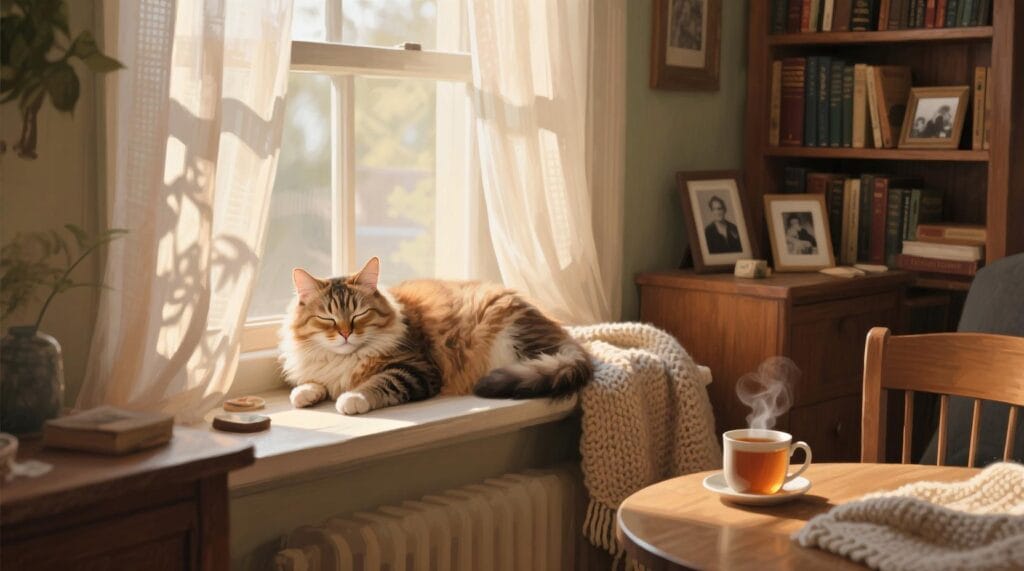
Cats have amazing memory skills that make them stand out from many animals. They have 300 million neurons, more than dogs’ 160 million. This means cats can process and learn information in a unique way.
Studies show that adult cats think like 2-year-old toddlers. They remember complex places, know who people are, and even guess what’s next. It’s pretty impressive.
- Cats outperform dogs in spatial memory tasks
- Feline memory allows for intricate problem-solving
- Cats can recall specific locations and experiences for extended periods
Each species has its own memory strengths. While primates are great at remembering social stuff, cats are top in spatial and associative memory. They remember when to eat, find their way around, and even smell out who’s who.
Looking at how cats compare to others, we see they have a smart memory system. It’s not just simple reactions. Their brains work in complex ways, showing they’re smarter than many think.
Training and Memory Enhancement
Understanding cat memory opens up exciting possibilities for effective training. Cats have remarkable learning abilities that can be enhanced through strategic approaches. Their procedural memory allows them to retain skills and experiences for extended periods.
When training your cat, consider these key strategies to optimize cat memory and learning:
- Use positive reinforcement techniques
- Create consistent training routines
- Leverage observational learning
- Provide mental stimulation
Cats learn best through repetition and engagement. Short, frequent training sessions work more effectively than long, exhausting ones. Reward-based methods help strengthen neural connections and improve cat memory retention.
Different training techniques can significantly impact your cat’s cognitive abilities:
| Training Method | Memory Impact | Duration of Learning |
|---|---|---|
| Clicker Training | High cognitive engagement | Long-term skill retention |
| Interactive Toys | Problem-solving skills | Continuous mental stimulation |
| Puzzle Feeders | Spatial memory development | Persistent learning |
Mental enrichment plays a crucial role in maintaining and enhancing cat memory. Environmental complexity, interactive play, and targeted training can help keep your cat’s cognitive abilities sharp throughout their life.
Memory-Related Health Issues in Cats
As cats get older, their memory can change a lot. This affects their brain health. Knowing about these changes helps cat owners take better care of their aging pets.
Older cats can face memory loss, which changes their life a lot. This condition is like what happens in humans as they age.
Cognitive Dysfunction Syndrome: What Cat Owners Should Know
Feline Cognitive Dysfunction (FCD) is a serious brain condition. It affects a cat’s memory and thinking. Cats with FCD may show signs like:
- Getting lost in places they know
- Changes in when they sleep and wake
- Not wanting to play or interact
- Not listening to commands
- Forgetting things
Treatment Options for Cognitive Health
There are many ways to help cats with memory problems. Vets suggest:
- Playing with them to keep their mind sharp
- Feeding them food that’s good for their brain
- Going to the vet regularly
- Making their environment interesting
- Medicine to slow down memory loss
Spotting problems early and acting fast can really help your cat’s brain health and happiness.
Cat Memory in Daily Life

Your cat’s memory is more complex than you think. It plays a big role in their daily life. They remember routines, people, and places with great detail.
Cats form strong emotional bonds through their memory. They don’t just remember events; they recall them as sensory and emotional experiences. When they see a familiar face or place, their memory brings back emotions from past interactions.
- Recognizing feeding times with remarkable accuracy
- Remembering favorite play areas and toys
- Identifying safe and potentially threatening environments
- Recalling specific human interactions and behaviors
Knowing about cat memory can make your bond with your cat stronger. Cats store memories through smell, sound, and sight. This helps them build detailed mental maps of their world.
Your cat’s memories are not just recordings; they are tools for survival and social interaction. They use memories to predict what will happen, avoid dangers, and find good experiences. By understanding these memory processes, you can make your cat’s life better and more comfortable.
“Cats remember with their hearts as much as their minds.” – Feline Behavior Experts
Conclusion
Exploring cat memory opens up a world of fascinating complexity. Cats have amazing memory skills that go beyond just recognizing things. They can process, store, and recall information, showing off their smart brains.
Studies on cat memory keep revealing new and interesting facts. These pets can remember places, people, and even changes in their surroundings. Their memory is not just a basic function but a complex system that helps them understand and interact with the world.
As we learn more about cat brains, we get a better view of how they see and interact with their world. Research on cat memory helps us improve how we care for them, train them, and connect with them on a deeper level.
The study of cat memory is set to uncover even more amazing things. By digging deeper into how cats remember, we can find new ways to support their mental health. This will help us appreciate their unique mental abilities even more.
FAQ
How long is a cat’s short-term memory?
Cats’ short-term memory lasts from 16 hours to several days. It depends on how important the experience is. They can remember where food is or specific events for a long time.
Can cats remember people after long periods of separation?
Yes, cats remember people well. They use what they see, hear, and smell to remember. Many cats recognize family members even after months or years apart.
Do cats have good spatial memory?
Cats are great at remembering where things are. They make mental maps of their area. This helps them find food, safe spots, and mark their territory.
How does aging affect a cat’s memory?
Older cats might forget things more easily. They can get Feline Cognitive Dysfunction (FCD). But, keeping them mentally active and seeing the vet regularly can help.
Can cats remember traumatic experiences?
Cats remember scary events for a long time. These memories can make them act differently. But, positive experiences and gentle help can help them get over it.
How important is scent in a cat’s memory?
Scent is very important for cats. They use it to know who’s who, mark their territory, and connect with others. Their sense of smell is very strong.
Do cats have object permanence?
Yes, cats understand that things still exist even if they can’t see them. This helps them solve problems and hunt. It’s a skill they learn as they grow up.
How can I help improve my cat’s memory?
You can make your cat’s brain work harder with toys, puzzles, and play. Keeping a routine and introducing new things keeps their mind active.
